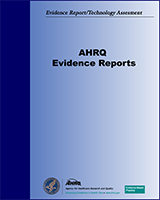This publication is provided for historical reference only and the information may be out of date.
Use of Glycated Hemoglobin and Microalbuminuria in the Monitoring of Diabetes Mellitus
Evidence Reports/Technology Assessments, No. 84
Authors
Co-Principal Investigators: Sherita Golden, MD, MHS and L Ebony Boulware, MD, MPH. Investigators: Gail Berkenblit, MD, PhD, Frederick L Brancati, MD, MHS, Geetanjali Chander, MD, MPH, Spyridon Marinopoulos, MD, MBA, Michael Paasche-Orlow, MD, MPH, Neil Powe, MD, MPH, MBA, and Tejal Rami, MPH.Structured Abstract
Background:
While testing for glycemic control and urine albumin are widely recommended for persons with Types 1 and 2 diabetes mellitus, there has not been a systematic assembly of the literature to assess the risk relation between tests assessing long-term glycemic control or tests assessing the presence of microalbuminuria to future cardiovascular, peripheral vascular, renal, and neurological outcomes (all of which represent end-organ effects of long-term diabetes). This report, commissioned by the American Association of Clinical Chemistry, systematically reviews the literature identifying the risk relation between testing for glycemic control and urine albumin with these important clinical outcomes.
Search Strategy:
Electronic searches were completed of PubMED, and hand searching of key journals, conference proceedings, and references lists.
Selection Criteria:
Articles were included in this evidence report if they were English language reports of prospective studies in which original data was reported. It was required that one of the specific research questions be addressed in non-pregnant adults.
Data Collection and Analysis:
Quality analysis and data abstraction were performed by pairs of reviewers. For each study question, evidence tables were developed and qualitative synthesis was completed.
Main Results:
The evidence supports a strong, graded relation between the level of glycated hemoglobin and the risk of two major microvascular complications of type 1 and type 2 diabetes, retinopathy and nephropathy. These patterns are observed for various measures of glycated hemoglobin (i.e., HbA1c, HbA1, and total GHb). Cohort studies evaluating coronary artery disease and peripheral arterial disease demonstrated a positive association with glycated hemoglobin exposure in persons with types 1 and 2 diabetes (although risk estimates were much smaller compared to the risk estimates for the microvascular complications). The risk relationship between cerebrovascular disease and glycated hemoglobin is less clear. For studies on urine albumin, reporting of methods for measurement of urine albumin and reporting of cutoffs for microalbuminuria were varied. The evidence supports the association of microalbuminuria at baseline with progression of kidney disease, all-cause death, and cardiovascular morbidity and mortality. These relations appear to be graded with greater levels of urine albumin excretion at baseline predicting greater risk of these outcomes at follow up.
Conclusions:
Glycated hemoglobin was strongly associated with an increased risk of microvascular complications as well as macrovascular complications, although the association was weaker for macrovascular disease. Microalbuminuria was associated with progression of chronic kidney disease and the development of cardiovascular morbidity, cardiovascular mortality, and all-cause death. This synthesis is limited by the significant heterogeneity in the measurements of glycated hemoglobin and microalbuminuria as well as heterogeneous measurements for clinical outcomes making comparisons across studies difficult. For research on glycemic control, future work should focus on studying the relation between glycated hemoglobin exposure and the risk of neuropathy and macrovascular complications and determining whether there is a threshold for the effect of glycated hemoglobin on these outcomes. Because of the heterogeneity in the literature on reporting of glycated hemoglobin, future cohort studies and clinical trials should aim to use standardized methods to allow risk comparison across studies. For research on urine albumin, future work should seek to define the optimal and most feasible measures of microalbuminuria and to standardize measurement of microalbuminuria in persons with diabetes. Future research should also characterize the nature of the relation between microalbuminuria and outcomes.
Prepared for: Agency for Healthcare Research and Quality, U.S. Department of Health and Human Services.1 Contract No. 290-97-0006. Prepared by: Johns Hopkins Evidence-based Practice Center.
Suggested citation:
Golden S, Boulware LE, Berkenblit G, Brancati F, Chander G, Marinopoulos S, Paasche-Orlow M, Powe N, Rami T. Use of Glycated Hemoglobin and Microalbuminuria in the Monitoring of Diabetes Mellitus (Evidence Report/Technology Assessment No. 84 (Prepared by Johns Hopkins Evidence-based Practice Center under Contract No. 290-97-0006). AHRQ Publication No. 04-E001. Rockville, MD: Agency for Healthcare Research and Quality, U.S. Department of Health and Human Services. October 2003.
This report may be used, in whole or in part, as the basis for development of clinical practice guidelines and other quality enhancement tools, or a basis for reimbursement and coverage policies. AHRQ or U.S. Department of Health and Human Services endorsement of such derivative products may not be stated or implied.
AHRQ is the lead Federal agency charged with supporting research designed to improve the quality of health care, reduce its cost, address patient safety and medical errors, and broaden access to essential services. AHRQ sponsors and conducts research that provides evidence-based information on health care outcomes; quality; and cost, use, and access. The information helps health care decisionmakers—patients and clinicians, health system leaders, and policymakers—make more informed decisions and improve the quality of health care services.
The authors of this report are responsible for its content. Statements in the report should not be construed as endorsement by the Agency for Healthcare Research and Quality or the U.S. Department of Health and Human Services of a particular drug, device, test, treatment, or other clinical service.
- 1
540 Gaither Road, Rockville, MD 20850. www
.ahrq.gov
